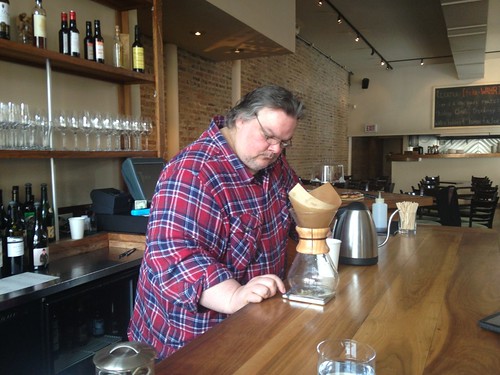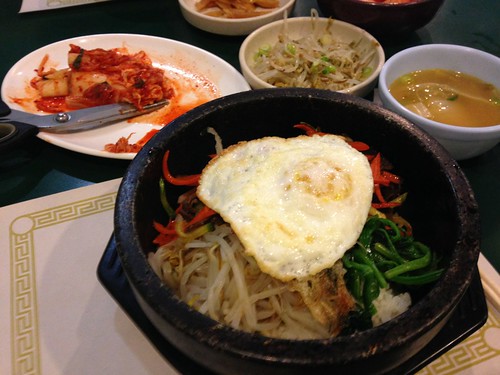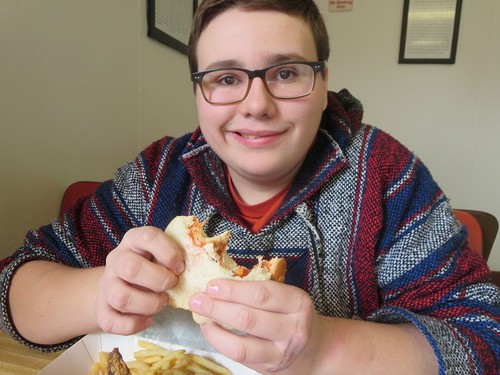
I popped into Vera one morning recently for coffee. A couple of my friends were already there, chatting up Mark and Liz Mendez about the new coffee and doughnuts they’ve started serving. It didn’t feel like being at a restaurant, though, which is to say, it felt like what all restaurants should feel like, hanging out with friends. The Mendezes were talking about the coffee they had selected, the one that came the closest to the perfection they had in their heads. Mark talked about making coffee and how the tiniest changes—quantity of beans, water temperature, etc.— could radically affect the final beverage. He weighed out the water on a scale, he weighed out the beans, he took three or four minutes to pour me what turned out to be the best cup of coffee I’ve ever had in my life.
A bit later I decided I might as well eat lunch, so I ordered a tortilla (the Spanish potato-egg-pie kind). A perfect simple little plate, with a perfectly-dressed salad on top. Do I really mean to use “perfect” this many times? Am I not setting off a round of adjective inflation? No I am not, and yes I do. Everything tasted the best it could ever hope to be, not because it had shaved truffle on top but because it was itself, in perfect balance and harmony. Mark said of the tortilla he made that he didn’t even like that kind of cold snack, he doesn’t like cold leftover pizza. Think about that. He made the best example imaginable of something… that he doesn’t even like.
This is why I love Vera. In a show-offy scene, and I’m all for that so far as it goes, he’s seeking the perfection of humble things, he’s obsessive in pursuit of the small details that mean everything. He’s Hattori Hanzo, making the best swords on earth. To eat food of such unassuming quality in a setting of such easygoing welcomingness is the thing all of us who love restaurants love, love to fall in love with. We search for new places to fall in love with. Sometimes it happens, sometimes you only see how easy it is to fall short…

This post needs another picture. Chocolate doughnut at Vera.
Charlatan. I’ve liked what Matt Troost does with Italian food since the short-lived Fianco, and I’m far from alone in my love for Three Aces. Service there has always been, charitably, random at best, but it was a bar so you took it in stride. Charlatan is still something of a bar but generally seems to be more of a restaurant. This is news that has not entirely reached the service staff. I’ll take it in stride when I’m greeted, as you so often are, with a puzzled, increasingly hopeless examination of the reservation system— “You say it’s… Gebert? And you have a reservation… here?” I think that’s an unforced error— is it that hard to have passing familiarity with your 6 pm reservations at 6 pm, or at least pretend, “Ah, yes Mr. Gebert, your table is right this way”? That would go so far to set the evening off on a welcoming note, rather than one that feels like getting stopped at Immigration.
But that happens everywhere, almost. I have to say, though, there was one thing that really put the vague service in perspective. A plate of octopus was brought to the table with the customary greeting, “This plate is really hot,” and set on a corner by me and Liam, my 13-year-old. And then… our waitress walked away. And I realized I had no way to share it with anybody else at the table who might actually want it, like my wife. I didn’t have a spoon; I couldn’t pass the hot plate. They might as well have delivered it in a lockbox without the combination. I had to flag our waitress like she was a cab to get something to serve it with, a request that seemed to strike her as no more than a harmless eccentricity to be indulged in a customer.
The octopus, by the way, was terrific. Mike Sula described it as “the beefiest-tasting octopus you’ll ever encounter,” which I took to mean that it was big chewy pieces like octo-steak, but no, clearly there was all kinds of rich beef stock this stuff had been stewing in until it was marshmallow soft and tasted like an octopus that had been clutching a Christmas roast. There were some fantastic glazed carrots in it and a sort of romesco pesto all around it, looking like ground circus peanuts. This was a dish that promised all kinds of wonders and made you want to keep Charlatan close to you forever.
Surprising, then, that the star attraction— pasta— fell short in varying degrees. A plate of rabbit casconcelli (imagine really long agnolotti) had beautiful supple texture, but the meat was lost in mascarpone and golden raisins, sweet wrestling savory to the mat without much of a fight. Still, the silky texture of the pasta was entrancing. My wife and one son both ordered different dishes of spaghettini, though, and in both cases they quickly solidified into solid clumps of pasta. I debated with some friends on Twitter the probable cause— too much starch left in the water by a busy kitchen? Fresh pasta not sauced fast enough? I don’t know, but after 5 minutes you had to saw this stuff like a pork chop, and one of them which promised a sprinkling of chili powder was showered in snowdrifts of the stuff the way the beignets at Cafe du Monde are coated in powdered sugar.
So I’d love to love Charlatan, there’s huge potential here and some dishes that I’m sure on some days are great, since I had at least one. But I suspect it’s a place that became a hit faster than it could learn its own ropes and assure a constant level of quality. I’ll go back in three or six months and see where it is then.

Uni toast at The Izakaya at Momotaro.
The Izakaya at Momotaro. I wrote a lengthier review of this at the Reader, so go there for that. Short answer: atmosphere and cocktails only go so far to take you to Japan, but the food is really well executed. Interestingly, when I left the place I said to my dining companion “I really liked that, but we kind of ate everything I would want to eat on the menu, I don’t know how quickly I could go back. In the week since then, though, I’ve felt love growing in me. The big Momotaro upstairs is kind of intimidating, flashy and noisy and expensive; the downstairs feels like where you could go and be one with your Japanese food experience. And that seemed to be how the servers and cooks acted, too—like they knew that the real communion with their food was happening in this quiet, more contemplative space. The zen at Momotaro is downstairs.

Dal Paeng Yi. There’s a Korean strip on Bryn Mawr that I try every few years. It seems like there should be some real family-run charmer along there, but I have yet to find it. I hit this place with a friend for lunch one day, it was friendly and they could use the business, I wanted to be charmed, but it was just fair. It claims to be a Korean noodle shop, though noodle dishes were mostly crossed off of the most-crossed-off menu I’ve ever seen. Anyway, my friend had soup— I think hanjae guk, I forget— which he didn’t think much of, I had bibimbop in a stone pot which was decent, too much sochugang (hot sauce) in it but it at least developed a little bit of a crispy rice crust, though not like the fearsomely crisped-up crust I cut my teeth on at the late Kang Nam in Chowhound days. So it was just fair, I think the couple who run it are well on their way into retirement and its better days are behind it.

Scofflaw is an old vet of our scene by now, but I’d never been there, partly because I’m happy for good cocktails but not so much on the prowl for them that I’d find myself at Kedzie and Armitage wanting them. But I’m working on a piece about a certain food item for Thrillist right now, and they were reputed to have a good one. All the internet affirmed this, so of course I get there and it’s been off the menu for a year. But I’m told, the burger is good, it’s like their take on an In’N’Out burger. Well, it’s not bad, but it kind of shows how getting that kind of balance with things like lettuce and tomato on a burger is hard; I don’t get as much burger out of the burger as I’d like, I get a lot of lettuce and tomato dressed with mustard. The most basic of American dishes, but not always that easy, it turns out. They get the fries right, but the pimenton sauce that comes with them is oddly flavorless; if you’re going to replace Heinz, the replacement actually has to be better than ketchup. Easy to see why people love a neighborhood place serving high level craft cocktails for $8 or $9, but based on what I had this isn’t much of a food destination— at least not until you’re looking at it through a couple of cocktail goggles.
Dough Bros. This has gotten relatively little notice, except from my friend Ken Zuckerberg, and at first glance it would call for little notice. It’s a nondescript Formica-clad pizza slice joint downtown, on a low-rent strip of State Street next to some bar you never went into on your way home after work or whatever. If the name registers at all it’s probably because of the really odd fact that one of the guys who developed it was Roland Liccioni, as in, the classical French chef of Les Nomades, etc. (See Mark Mendez talking about him here.) I don’t know if he’s still involved, though there is still a pizza slice called The Roland; in any case, to me it just looked like a typical slice joint doing something kind of like New York style, stiff, slightly burnt-looking slices in the case. They didn’t look like a minute or two in a hot oven would do much more than dry them out even further, but I figured it was worth a $4 experiment. I ordered the Roland— lemongrass-tinged sausage and a criss-cross of Sriracha atop it; the pizza went in, and came out surprisingly quickly. No way this could be anything special.
From the first bite of the crust, crackly-crispy and yet with some deep chewiness, I was in awe. I was in love, in this unlovable space. The lemongrass sausage and other stuff on top were tasty, fresh, well-balanced, but above all that crust was just amazing, even more amazing for having come out so beautifully textured out of reheating. This is one of the best pizzas in the city, no joke. If you work near there, you need to go there today, and often.

Hienie’s Shrimp House is a fried chicken and shrimp stand on the southeast side— we have a southeast side, you ask? Yeah, basically it’s what you see from the Skyway just before you cross into Indiana, a deeply unlovely declined industrial area that once was the neighborhood around the steel mills. Anyway it was one of the places Titus Ruscitti did on this Thrillist list we each did half of, and Myles after reading it wanted to try some wings, so we decided to make the long trek there.
It’s a nothing place— I thought it’d at least be a bar, but it’s just a bare takeout place with a few tables— but the chicken was great. We ordered it both fried and as wings, and either way crispy and lightly seasoned, as good old school chicken as you’ll find in Chicago. The other thing Hienie’s is famous for is a luridly orange sauce for the chicken, in a color and consistency I last saw when my mom bought us a set of fluorescent paints in the 70s. It’s a local favorite on the southeast side (after it got some LTH attention, Kevin Pang wrote this piece that pretty well sums up its history, including that it doesn’t actually originate at Hienie’s, but never mind). It’s pretty easy to tell from your first taste where that tomato soup color comes from— it’s basically yellow mustard with bright red hot sauce in it. At first taste I didn’t think chicken needed a mustard taste, but it grew on me, and I wound up taking some with some chicken I made to a Super Bowl party so friends could sample the authentic taste of 103rd and Torrence. I love this town.

Myles takes the white bread from an order of wings, and some of my chicken from an order of chicken, and invents the Hienie’s Chicken Sandwich.
Vera
1023 W Lake St
Chicago, IL 60607
(312) 243-9770
Charlatan
1329 W Chicago Ave
Chicago, IL 60642
(312) 818-2073
The Izakaya at Momotaro
820 W Lake St
Chicago, IL 60607
(312) 733-4818
Dal Paeng Yi
3236 W Bryn Mawr Ave
Chicago, IL 60659
(773) 588-0305
Scofflaw
3201 W Armitage Ave
Chicago, IL 60647
(773) 252-9700
Dough Bros.
400 N State St
Chicago, IL 60654
(312) 600-9078
Hienie’s Shrimp House
10359 S Torrence Ave
Chicago, IL 60617
(773) 734-8400


 Posted in
Posted in 











